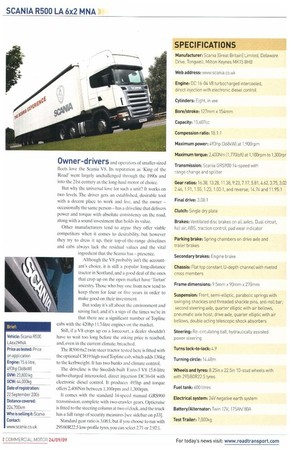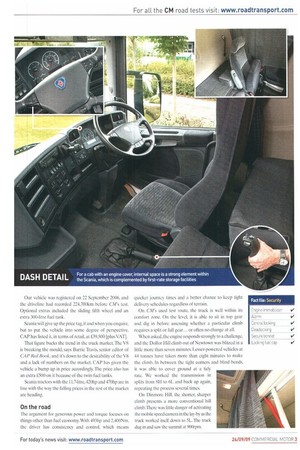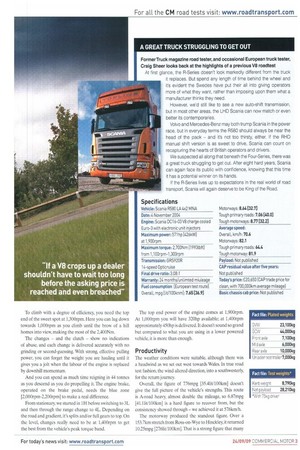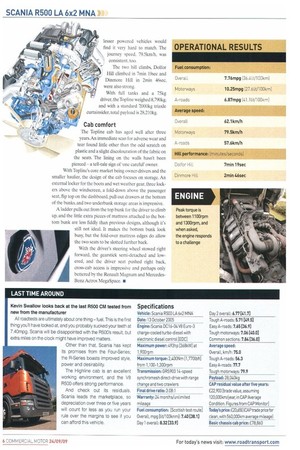Owner-drivers and operators of smaller-sized fleets love the Scania V8.
Page 32

Page 33

Page 35

Page 36

If you've noticed an error in this article please click here to report it so we can fix it.
Its reputation as 'King of the Road' went largely unchallenged through the 1990s and into the 21st century as the long-haul motor of choice.
But why the universal love for such a unit? It works on two levels. The driver gets an established, desirable tool with a decent place to work and live, and the owner occasionally the same person has a driveline that delivers power and torque with absolute consistency on the road, along with a sound investment that holds its value.
Other manufacturers tend to argue they offer viable competitors when it comes to desirability, but however they try to dress it up, their top-of-the-range drivelines and cabs always lack the residual values and the vital ingredient that the Scania has presence.
Although the V8 probably isn't the account ant's choice, it is still a popular long-distance tractor in Scotland, and a good deal of the ones that crop up on the open market have 'Tartan' ancestry. Those who buy one from new tend to keep them for four or five years in order to make good on their investment.
But today it's all about the environment and saving fuel, and it's a sign of the times we're in that there are a significant number of Topline cabs with the 420hp 11.7-litre engines on the market.
Still, if a V8 crops up on a forecourt, a dealer shouldn't have to wait too long before the asking price is reached, and, even in the current climate, breached.
The R500 6x2 twin-steer tractor tested here is fitted with the optional CR19 high-roof Topline cab, which adds 136kg to the kerbweight. It has two bunks and climate control.
The driveline is the Swedish-built Euro-3 V8 15.6-litre turbo-charged intercooled, direct injection DC16-04 with electronic diesel control. It produces 493hp and torque offers 2,400Nm between 1,100rpm and 1,300rpm.
It comes with the standard 14-speed manual GRS900 transmission, complete with two-crawler gears. Opticruise is fitted to the steering column at two o'clock, and the truck has a full range of security measures fsee sidebar on p33].
Standard gear ratio is 3.08:1, but if you choose to run with 295/60R22.5 low-profile tyres, you can select 2.71 or 2.92:L
Our vehicle was registered on 22 September 2006, and the driveline had recorded 224,700km before CM's test. Optional extras included the sliding fifth wheel and an extra 300-litre fuel tank.
Scania will give up the price tag, if and when you enquire, but to put the vehicle into some degree of perspective. CAP has listed it, in terms of retail, at £39500 [plus VAT].
That figure bucks the trend in the truck market. The V8 is breaking the mould, says Barrie Travis, senior editor of CAP Red Book, and it's down to the desirability of the V8 and a lack of numbers on the market. CAP has given the vehicle a bump up in price accordingly. The price also has an extra £500 on it because of the twin-fuel tanks.
Scania tractors with the 11.7-litre, 420hp and 470hp are in line with the way the falling prices in the rest of the market are heading.
On the road The argument for generous power and torque focuses on things other than fuel economy. With 493hp and 2,400Nm, the driver has consistency and control, which means quicker journey times and a better chance to keep tight delivery schedules regardless of terrain.
On C'M's used test route, the truck is well within its comfort zone. On the level, it is able to sit in top gear and dig in before assessing whether a particular climb requires a split or full gear... or often no change at all.
When asked, the engine responds strongly to a challenge. and the Dolfor I fill climb out of Newtown was blitzed in a little more than seven minutes. Lesser-powered vehicles at 44 tonnes have taken more than eight minutes to make the climb. In between the tight corners and blind bends, it was able to cover ground at a tidy rate. We worked the transmission in splits from 8H to 6L and back up again, repeating the process several times.
On Dinmore Hill, the shorter, sharper climb presents a more conventional hill climb. There was little danger of activating the mobile speed camera in the lay-by as the truck worked itself down to .51.. The truck dug in and saw the summit at 900tynn. To climb with a degree of efficiency, you need the top end of the sweet spot at 1,300rpm. Here you can lug down towards 1,000rpm as you climb until the brow of a hill homes into view, making the most of the 2,400Nrn.
The changes — and the clutch — show no indications of abuse, and each change is delivered accurately with no grinding or second-guessing. With strong, effective pulling power, you can forget the weight you are hauling until it gives you a jolt when the labour of the engine is replaced by downhill momentum.
And you can spend as much time reigning in 44 tonnes as you descend as you do propelling it. The engine brake, operated on the brake pedal, needs the blue zone [2,000rpm-2,200rpm] to make a real difference.
From stationary, we started in IH before switching to 3L and then through the range change to 4L. Depending on the road and gradient, it's splits and/or full gears to top. On the level, changes really need to be at 1,400rpm to get the best from the vehicle's peak torque band. The top end power of the engine comes at 1,900rpm. At 1,000rprn you will have 320hp available; at 1.400rpm approximately 450hp is delivered. It doesn't sound so grand but compared to what you are using in a lower powered vehicle, it is more than enough.
Productivity
The weather conditions were suitable, although there was a headwind as we set out west towards Wales. In true road test fashion, the wind altered direction, into a southwesterly, for the return journey.
Overall, the figure of 776mpg [35.4lit/100km] doesn't give the full picture of the vehicle's strengths. This route is A-road heavy, almost double the mileage, so 6.87mpg [41.11ft/100km] is a hard figure to recover from, but the consistency showed through — we achieved it at 576km/h.
The motorway produced the standout figure. Over a 153.7km stretch from Ross-on-Wye to Hinck ley, it returned 10.25mpg [276lit/100kml.Th at is a strong figure that many lesser powered vehicles would find it very hard to match. The journey speed. 79.5km/h. was consistent, too.
The two hill climbs, Dolfor Hill climbed in 7min 19sec and Dinmore Hill in 2min 46sec, were also strong.
With full tanks and a 75kg driver, the Topline weighed 8,790kg. and with a standard 7,000kg triaxle curtainsider. total payload is 28,210kg.
Cab comfort
The Topline cab has aged well after three years. An immediate scan for adverse wear and tear found little other than the odd scratch on plastic and a slight discolouration of the fabric on the seats. The lining on the walls hasn't been pierced — a tell-tale sign of 'one careful' owner. With Topline's core market being owner-drivers and the smaller haulier, the design of the cab focuses on storage. An external locker for the boots and wet weather gear. three lockers above the windscreen, a fold-down above the passenger seat, flip top on the dashboard, pull-out drawers at the bottom of the bunks, and two underbunk storage areas is impressive. A ladder pulls out from the top bunk for the driver to climb up, and the little extra pieces of mattress attached to the bottom bunk are less fiddly than previous designs, although it's still not ideal. It makes the bottom bunk look busy, but the fold-over mattress edges do allow the two seats to be slotted further back.
With the driver's steering wheel stowed right forward, the gearstick semi-detached and lowered, and the driver seat pushed right back, cross-cab access is impressive and perhaps only bettered by the Renault Magnum and MercedesBenz Actros MegaSpace. •












































































































































